
Saint Patrick's Saltire or Saint Patrick's Cross is a red saltire (X-shaped cross) on a white field, used to represent the island of Ireland or Saint Patrick, the patron saint of Ireland. In heraldic language, it may be blazoned Argent, a saltire gules. Saint Patrick's Flag is a flag composed of Saint Patrick's Saltire.
It was and is often used often used to represent the island of Ireland. Although there is no universally accepted flag for the island of Ireland. The antiquity of the saltire's association with Ireland and with Saint Patrick has been questioned by some, and it is rejected by some extremist Irish Republicans as a "British invention", although it is also rejected by some extreme Ulster Loyalists because it's an "All Ireland symbol"
It pre-dates the use of the Irish national flag by at least 150 years.The saltire was first used in the regalia of the Order of Saint Patrick, a British chivalric order established in 1783, and later in the arms and flags of a number of institutions. After the 1800 Act of Union joined the Kingdom of Ireland with the Kingdom of Great Britain, the saltire was added to the British flag to form the Union Flag still used by the United Kingdom. The saltire has occasionally served unofficially to represent Northern Ireland and been considered less contentious than other flags flown there.
Origins
he origins of Saint Patrick's saltire are unclear. The earliest unequivocal use of the saltire is in the official description of the badge of the Most Illustrious Order of Saint Patrick that Lord Temple, the Lord Lieutenant of Ireland, forwarded to his superiors in London in January 1783:
The Order of Saint Patrick was created in 1783. While the Order technically still exists, no knight of St Patrick has been created since 1936, and the last surviving knight, Prince Henry, Duke of Gloucester, died in 1974.And the said Badge shall be of Gold surrounded with a Wreath of Shamrock or Trefoil, within which shall be a Circle of Gold, containing the Motto of our said Order in Letters of Gold Viz. QUIS SEPARABIT? together with the date 1783, being the year in which our said Order was founded, and encircling the Cross of St Patrick Gules, surmounted with a Trefoil Vert each of its leaves charged with an Imperial Crown Or upon a field of Argent.

Insignia of a Knight of St Patrick
The use of the saltire in association with St Patrick was controversial because it differed from the usual crosses by custom worn on St Patrick's Day. In particular, the previous crosses associated with Saint Patrick were not X-shaped. Some contemporary responses to the badge of the order complained that an X-shaped cross was theCross of St Andrew, patron of Scotland, although modern vexillology allows only a blue-and-white design to be so called.

A cross pattée
Many subsequent commentators have assumed that the saltire was simply taken from the medieval arms of the FitzGeralds (or Geraldines), who were Dukes of Leinster. The Dukes of Leinster dominated the political and social scene of eighteenth century Dublin, from their ducal palace of Leinster House (later to become the seat of the Irish parliament and senate, the Oireachtas) William FitzGerald, 2nd Duke of Leinster was the premier peer in the Irish House of Lords and a founder member of the Order of Saint Patrick. On the other hand, Michael Casey suggests that Lord Temple, pressed for time, had based the Order's insignia on those of the Order of the Garter, and simply rotated its George's Cross through 45 degrees.

FitzGerald Coat of arms
A variety of sources show saltires in use earlier than 1783 in Ireland and in an Irish context, although there is no suggestion that they are linked to St Patrick.The earliest known evidence of the existence of the red saltire occurs in a map of "Hirlandia" by John Goghe dated 1576 and now exhibited in the Public Record Office. The arms at the head of this map are the St George's cross impaled on the crowned harp, but the red saltire is prominent in the arms of the Earl of Kildare and the other Geraldine families placed over their respective spheres of influence.The red saltire flag is flown at the masthead of a ship, possibly an Irish pirate, which is engaged in action in the St George's Channel with another ship flying the St George's cross. The St George's flag flies upon Cornwall, Wales and Man, but the red saltire flag does not appear upon Ireland itself, though it is placed upon the adjacent Mulls of Galloway and Kintyre in Scotland
English and German picture maps of the battle of Kinsale of 1601/2 show the combined Irish–Spanish forces under a red saltire. This is presumed to be the Cross of Burgundy, the war flag of the House of Burgundy that ruled Spain, rather than an Irish flag.
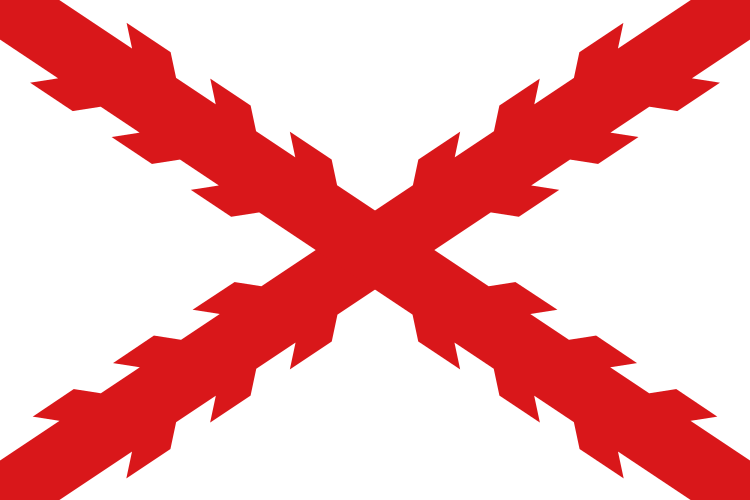
Cross of Burgundy
A 1612 seal of Trinity College Dublin shows uncoloured cross and saltire flags. These have been taken to represent England and Ireland respectively. On the assumption that they were the flags of st George and patrick they were further adapted in the modern arms of the college.

Arms of Trinity College Dublin
Contemporary reports of the ensigns of the Irish Catholic Confederation during the Wars of the Three Kingdoms state that each had a canton with a red saltire on a gold field. A 1645 picture map of the Siege of Duncannon shows Preston's Confederates under a saltire. The Irish Brigade raised by the Earl of Antrim and led by Alasdair Mac Colla had a gold flag featuring a crucifix and upper left canton with red saltire.
The flag used by the King's Own Regiment in the Kingdom of Ireland, established in 1653, shows a red saltire on a "taffey" yellow background. The origins of the regimental colours remain a mystery however.
The Graydon MS. Flag Book of 1686 which belonged to Pepys does not contain the red saltire, but gives as the flag of Ireland the green flag with St George's cross and the harp, illustrated in Plate X, fig. 3. Under the Commonwealth and Protectorate, when England and Scotland were represented their crosses, Ireland was invariably represented by the harp that was added to the English and Scottish crosses to form a flag of the three kingdoms.
At the funeral of Cromwell the Great Standards of England and Scotland had the St George's and St Andrew's crosses in chief respectively, but the Great Standard of Ireland had in chief a red cross (not saltire) on a yellow field.
![[Jack of 1658]](http://www.crwflags.com/fotw/images/g/gb-1658j.gif)
Flags of the Protectorate, 1653-59, note use of harp for Ireland rather than the saltire used in the modern Union Flag
A red saltire also appears on the flag of Berwick's regiment in the Irish Brigade of the French army.In the United States the 101st Infantry Regiment (organised in 1798) is a National Guard Unit from the State of Massachusetts, and was made up of citizens of Irish descent from Boston. Its arms feature a red saltire and a red cross pattée.

Flag of Berwick's regiment
A 1915 book about flags claims that The Protectorate of the 1650s briefly used a flag containing the St George's cross in the first and fourth quarters, St Andrew's cross in the second, and a red saltire on white in the third to represent Ireland. Several drawings of Union flags, including one of HMS Henry made c.1661 by Willem van de Velde, the elder, include a red saltire as in the post-1800 Union; but there is no official evidence for such a design.
Several atlases and flag books in the late 17th and 18th centuries show a red-saltire–on–white flag for Ireland; including Paulus van der Dussen's (c.1690), and Le Neptune françois, a marine atlas published in Amsterdam in 1693, where it is depicted with the legends Ierse above and Irlandois below — Dutch and French for "Irish". Jan Blaeu's 1650s atlas has a saltire on white for Ireland, which is hand-coloured red in some copies.
A 1785 newspaper report from Waterford states:
Upwards of forty vessels are now in our harbour, victualling for Newfoundland, of which number thirteen are of our own nation, who wear the St Patrick's flag (the field of which is white, with a St Patrick's cross, and an harp in one quarter.)
The origin of the saltire may be linked to the widespread custom of wearing crosses on Saint Patrick's Day in honour of the saint, though these crosses were generally not saltires. There is evidence of the custom from the seventeenth to the early twentieth century, which usually involved wearing a cross as a badge made of green or red paper or ribbon.
Modern use
St Patrick's Day
Today St Patrick's Cross is mostly used in conjucntion with other symbols on other flags, rather than as the origional flag itself. The most widespread probably being in the Union Flag of the United Kingdom. It is however still used by itself in some roles. It is used by the (Anglican) Church of Ireland.
Saint Patrick's Flag is sometimes seen during Saint Patrick's Day parades in Northern Ireland and Britain. Flags were handed out by Down District Council before the Downpatrick parade, near Patrick's burial place at Down Cathedral, in an attempt to create a parade that has cross community support. This has had only limited success however as in recent years Sinn Fein Counsolers refused to acknowledged it as an Irish Symbol and marched with the Irish Tricolour of the Irish Republic, which promoted wide spread condemnation. Controversy continues over the use of flags in the parade, and last year the council flag was used instead. In Great Britain, Saint Patrick's Flag was flown in place of the Irish tricolour at the 2009 parade in Croydon, prompting complaints from some councillors. It was flown on some years on Patrick's Day by Bradford City Council, which subsequently reverted to flying the Irish tricolour. I know that in my home city, St Patrick's Cross is flown over the local memorial hall during the celebrations, but not over any government or central buildings. (the council offices only use the city flag, and other government building use the union flag on designated days, one of which is St Patricks day)

late 19th/Early 20th Century St Patrick's Day Greeting Card
Use as Northern Ireland Flag
Despite representing all of Ireland, St Patrick's Cross has in recent years been used as a de-facto Northern Ireland Flag. The Ulster Banner not having offical status since 1973. St Patrick's Cross seems to be used increasingly as an alternative, which seems natural as it is NI's representation in the Union Flag, and is seen as less controversial in NI than other flags. At the 1935 celebrations in London for George V's silver jubilee, "The cross of St George representing England and Wales, and the saltires of St Andrew and St Patrick, representing Scotland and Ireland" were flown separately and used in combination. At the time the Irish Free State was a separate Dominion within the British Commonwealth. In 1986, government policy during state visits to London was to fly the crosses of George, Andrew and Patrick and the Welsh Dragon..
The Royal Barge Gloriana during the 2012 Thames Diamond Jubilee Pageant flew flags for the four "home nations" of the United Kingdom, including the Saint Patrick's Cross for Northern Ireland.
The all-island bodies for men's and ladies' bowls compete internationally under the Saint Patrick's flag.
The politician David McNarry has suggested the saltire should be allowed in Northern Irish number plates analogous to the flags allowed on English, Scottish, and Welsh plates.
The Union Flag (and the EU flag but it is seldom used if ever) is the only flag that has official status in Northern Ireland, and St Patrick's Cross has no official status in either Northern Ireland or the Republic of Ireland.
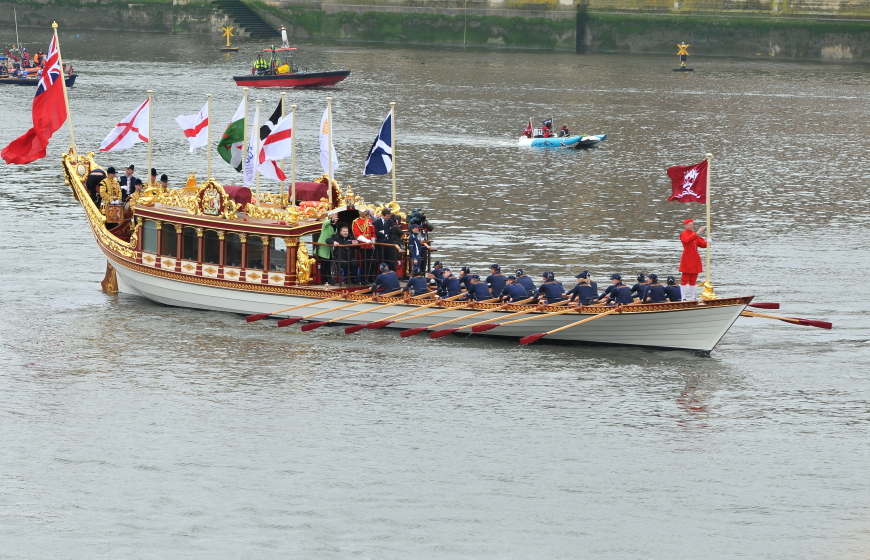
Barge Gloriana on the Thames during Jubilee Pageant ceremonially wearing the flags of the home nations. Note use of St Patrick's Cross (flag closed to the stern on the starboard side) for Northern Ireland.(the inclustion of the London and Cornwall flags is also interesting)
NI Sport organisations such as hockey, fencing and archery often use the St Patrick's Cross for the national Youth team as an alternative to the Ulster Banner which is used by most of the adult teams.

Northern Ireland Archery Society's Youth Team with St Patrick's Cross
Heraldry
Regardless of the uncertainty over its origins, the red saltire, or saltire gules on a white field was used in the arms and badges adopted by various organisations, its been adopted into badges and arms of organisations, towns and citties north and south as well as Irish organisations outside of Ireland. As already mentioned The arms of Trinity College Dublin show two flags, a red cross on white and a red saltire on white, which Hayes-McCoy and Galloway interpret as representing England and Ireland respectively.The arms were granted by Arthur Vicars in 1901, based on a 1612 seal showing uncoloured cross and saltire flags. The arms of Cork city show red-saltire flags on the two towers, though not on versions prior to 1800. Coleraine Borough Council includes Saint Patrick's Saltire, as Patrick is said to have given Coleraine its name. The saltire also appears in the coat of arms of the Co. Mayo town of Westport to commemorate the visit of St Patrick to the nearby mountain,Croagh Patrick. It also appears on the arms of Co. Fermanagh. A red saltire also appears on the arms of County Kildare, but this is probably because of the association of Kildare with the Fitzgerald Clan.

Coat of arms of the NI town of Coleraine
The original arms of the Royal Irish Academy in 1786 did not have the saltire, but those granted in 1846 do. There are red saltires in the arms of the Queen's University in Ireland (est.1850, arms granted 1851; dissolved 1879) and its successor Queen's University Belfast (est.1908, arms granted 1910);and the Royal College of Surgeons in Ireland.
The Church of Ireland diocese of Connor's arms, granted in 1945, include Saint Patrick's Saltire in memory of his supposed enslavement at Slemish. The Roman Catholic Archdiocese of New York, whose cathedral is St Patrick's, incorporates the saltire.
St Patrick's National School in Drumcondra, Dublin City has a saltire on its arms. St. Patrick's High School, Ottawa has the saltire in its flag and arms.
The Law Society of Northern Ireland also has a St Patrick's Saltire defaced with a red hand of Ulster and six pointed star (similar to some NI Flag proposals).

Coat of arms of Archdiocese of New York
Although not coats of arms it is also incorporated into heraldic badges particularly in police and military organizations. The Irish Guards adopted a badge based on the Order of St Patrick. The motto of that regiment is also adopted from the Irish order of chivalry. Although this badge is not worn when the regiment is in its cerimonial red tunics and bearskin caps, nor does it appear on the regimental colours. But it is worn in the beret (and caubeen for pipers) in the everyday working and combat uniform.

Interestingly their is also a picture of the same regiment flying St Patrick's Cross from a base in Afghanistan, on the UK government Website.See Here.
As part of the 1998 Good Friday Agreement the Northern Ireland Police Force called the Royal Ulster Constabulary (RUC) was reformed into a new police force called the Police Service of Northern Ireland (PSNI). This new force needed a new badge and the central design included St Patrick's Cross. (it is also notable that this badge was supported by all the Political Parties in NI at that time.)

The St Patrick's Cross is also used in some of the rank badges of the PSNI, often taking the place that a crown would in other UK police forces. See Here.
In Combination
The most widespread use of St Patrick's Saltire today is in the Flag of the United Kingdom. With the 1800 Act of Union that merged the kingdoms of Great Britain and Ireland, the red saltire was incorporated into the Flag of the United Kingdom as representing Ireland. The red saltire is counter changed with the saltire of St Andrew, such that the white always follows the red clockwise. The arrangement accounts for the discontinuous look of the red diagonal lines, and has introduced a requirement to display the flag "the right way up", with the white line of St Andrew above the red of St Patrick in the upper left hand quarter next to the flagpole. As with the red cross, so too the red saltire is separated by a white fimbriation from the blue field. This fimbriation is repeated for symmetry on the white portion of the saltire, which thereby appears wider than the red portion. The fimbriation of the cross of St George separates its red from the red of the saltire.

This video shows how the saltire in incorporated into the UK flag:
In a similar way to the Union Jack the Ulster Nation Flag, (originally and still used by Northern Ireland Independence (from both UK and Ireland) but also used by unionists today.) combines the cross of St Patrick with the Cross of St Andrew. Although this flag breaks the rules of heraldry as their is no white fimbriation.

Ulster Nation Flag
Other flags that use St Patrick's Cross
The Saint Patrick's Saltire was on the flag proposed in 1914 of the County Down unit of Irish Volunteers. A writer in The Irish Volunteer complained that The O'Rahilly should have known the saltire was "faked for Union Jack purposes".
In 1932-33 a variation of the flag with a St Patrick's blue background was adopted as the badge and flag of the short-lived Blueshirt fascist movement. This militant group incorporated right-wing, conservative and some former-unionist elements in opposition to the then left-wing republican Fianna Fáil party.

flag of Cumann na nGaedheal, the Blueshirts, and early Fine Gael
The saltire is incorporated in the badge of the Reform Movement, a "post-nationalist" pressure group in the Republic of Ireland seeking closer ties with the United Kingdom.
he saltire appeared on the house flag of Irish Shipping, founded 1941, and that used by Irish Continental Line in1973–9.

Irish Shipping Ltd House Flag
It replaced the St George's Cross in 1970 on the flag of the Commissioners of Irish Lights. The badge of the Royal Society of Antiquaries of Ireland, designed by John Vinycomb, incorporates the saltire and the arms of the four provinces.
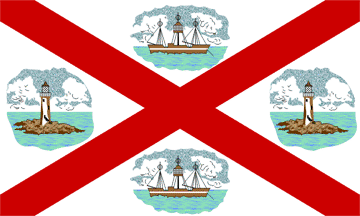
Commissioners of Irish Lights House Flag
Its also used in the flags of the Royal College of Surgeons Ireland in Dublin and the standard of Queens University Belfast.


Left: Flag of the College of Surgons Ireland and Right: Standard of Queens University
Similar but unrelated flags
The red saltire on white field is common in the world of Vexiolagy but not all are St Patrick's Cross. In the system of International maritime signal flags a red saltire on a white background is the signal flag for the letter V, "VICTORY" and the message "I require assistance". This means that any attempt to use the saltire as a maritime ensign could lead to confusion. A similar situation applies to St Andrew's Saltire, the flag of Scotland which closely resembles the maritime signal flag M, "MIKE", which means "My vessel is stopped; making no way." For this reason, a campaign was launched in Scotland in November 2007 seeking official recognition to use the historic Scottish Red Ensign instead.
The flag of Jersey has unknown origins, and a link with St Patrick's saltire has been proposed. The FitzGerald family who were powerful in Ireland, were Anglo-Norman in origin and also owned land in Jersey. Alternatively, N. V. L. Rybot in 1951 suggested that Jersey's flag originated from a mistake in a 1783 flag book by Carington Bowles, which was copied by later authors. Rybot's theory is that Bowles misinterpreted Ierse (Dutch for "Irish") as meaning "Jersey" in a Dutch flag-book he used as a source. However, French Admiralty charts show that Jersey was using the red saltire before 1783.
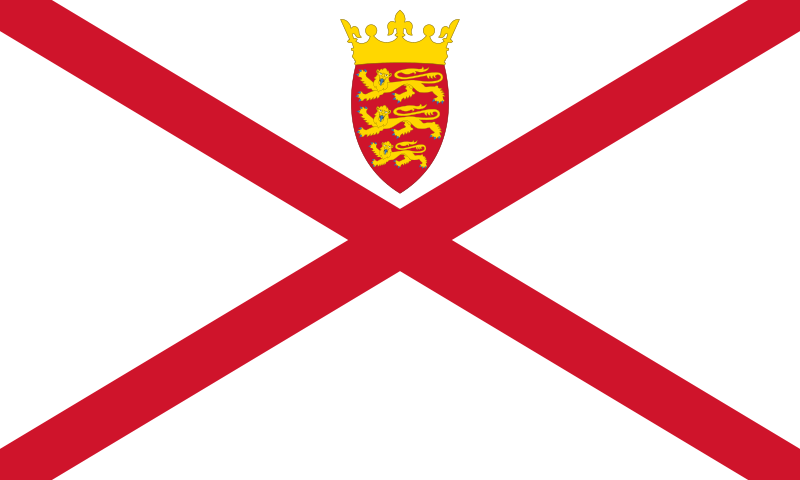
Flag of Jersey
The flags of Florida(below left), Alabama (below centre) and Valdivia in Chile (below right) are all derived from the Spanish Cross of Burgundy. But are often (and easily) mistaken for St Patrick's Cross.


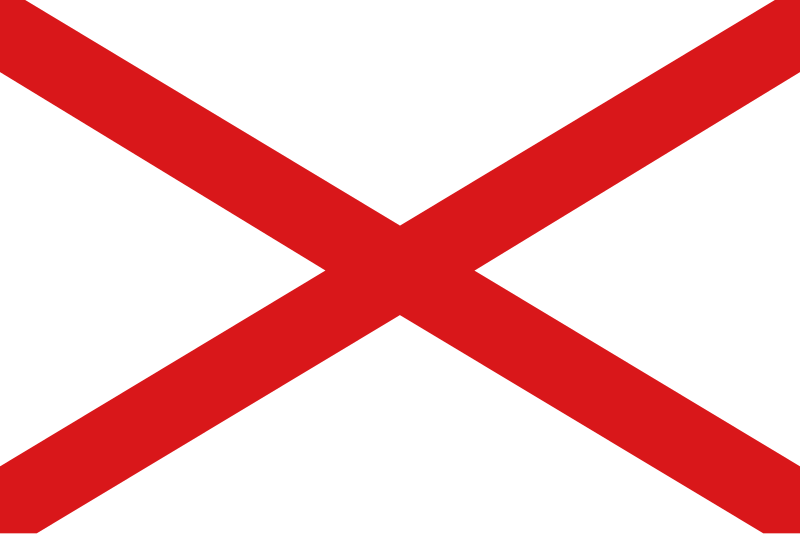
Regardless of whatever it's true origins are St Patrick's Cross is a historical flag of Ireland, it is one of the few all island flags, and a symbol which I think is often neglected North and South, and I would like to see more of it on St Patricks Day as it does bear the saints name (if it has any connection to him is debateable) and is an all Ireland symbol. I am not sure if it should be used the way it is for Northern Ireland, however I do think if it was adopted with other symbols into an NI flag it would be OK.
Feel Free to Comment and happy St Patricks Day.
Feel Free to Comment and happy St Patricks Day.
Information sourced from a range of sources mostly Wikipedia, picture are from a range of sources and are not owned by me.
will u consider doing an article on flag designs for a potential united ireland sometime
ReplyDeleteI would assume that if Ireland united under the banner of a Republic the current Tricolour would continue to be used. But for creative purposes I will have ago.
Deletecheers
DeleteOn the Alabama state flag, the description in its state constitution describes it as the "Crimson cross of St. Andrew," suggesting an affinity with Scots-Irish or Ulster Scots ancestry.
ReplyDeleteOn the Alabama state flag, the description in its state constitution describes it as the "Crimson cross of St. Andrew," suggesting an affinity with Scots-Irish or Ulster Scots ancestry.
ReplyDeleteI am aware of that, however I beleive its a confusion of terminology. I think they mean crimson saltire rather than St Andrew's Cross, as strictly speaking a St Andrews Cross is a white saltire on a blue field. Many scots and non Scots alike call their flag the saltire and this has led to the confusion of the terms saltire (an X shape cross) and St Andrews Cross being interchangeable which they aren't. sorta like St Andrews Cross is a saltire but not all saltires are St Andrew's Cross.
Delete